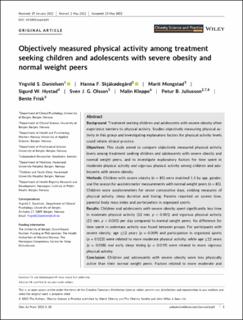Objectively measured physical activity among treatment seeking children and adolescents with severe obesity and normal weight peers
Danielsen, Yngvild Sørebø; Skjåkødegård, Hanna Flækøy; Mongstad, Marit; Hystad, Sigurd William; Olsson, Sven J. G.; Kleppe, Malin; Juliusson, Pétur Benedikt; Frisk, Bente
Peer reviewed, Journal article
Published version
Permanent lenke
https://hdl.handle.net/11250/3023350Utgivelsesdato
2022Metadata
Vis full innførselSamlinger
- Import fra CRIStin [3604]
- Institutt for helse og funksjon [584]
Originalversjon
Danielsen, Y. S., Skjåkødegård, H. F., Mongstad, M., Hystad, S. W., Olsson, S. J. G., Kleppe, M., Juliusson, P. B., & Frisk, B. (2022). Objectively measured physical activity among treatment seeking children and adolescents with severe obesity and normal weight peers. Obesity Science & Practice 10.1002/osp4.624Sammendrag
Background
Treatment seeking children and adolescents with severe obesity often experience barriers to physical activity. Studies objectively measuring physical activity in this group and investigating explanatory factors for physical activity levels could inform clinical practice.
Objectives
This study aimed to compare objectively measured physical activity levels among treatment seeking children and adolescents with severe obesity and normal weight peers, and to investigate explanatory factors for time spent in moderate physical activity and vigorous physical activity among children and adolescents with severe obesity.
Methods
Children with severe obesity (n = 85) were matched 1:1 by age, gender, and the season for accelerometer measurements with normal weight peers (n = 85). Children wore accelerometers for seven consecutive days, yielding measures of physical activity, sleep duration and timing. Parents reported on screen time, parental body mass index and participation in organized sports.
Results
Children and adolescents with severe obesity spent significantly less time in moderate physical activity (12 min, p < 0.001) and vigorous physical activity (21 min, p < 0.001) per day compared to normal weight peers. No difference for time spent in sedentary activity was found between groups. For participants with severe obesity, age ≤12 years (p = 0.009) and participation in organized sports (p = 0.023) were related to more moderate physical activity, while age ≤12 years (p = 0.038) and early sleep timing (p = 0.019) were related to more vigorous physical activity.
Conclusion
Children and adolescents with severe obesity were less physically active than their normal weight peers. Factors related to more moderate and vigorous physical activity in children with severe obesity were lower age, participation in organized sports and earlier sleep timing.

